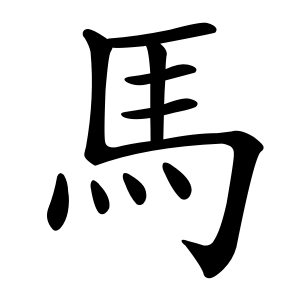馬
- horse;
Etymology
馬 (마) is a pictographic character created to imitate the shape of a horse.
In early script forms—especially in oracle bone script and bronze inscriptions—the outline of a horse is clearly visible, with details like the mane, legs, and tail rendered quite recognizably.
Usage in Korean
In its radical form, 馬(마) can appear in different positions within a character, such as:
변 (left side)
방 (right side)
발 (bottom part)
Due to the horse’s historic role as a primary mode of transportation, the 馬 radical is often found in characters:
1. Directly related to horses
2. Or more broadly connected to riding, travel, or motion
Because of this, it's also sometimes used alongside 車 (차, vehicle) to indicate conveyance or movement.
Here are several common characters that use 馬 as their radical:
驛 (역) – post station
驅 (구) – to drive, urge on (e.g. drive horses)
騷 (소) – noisy, restless (originally described a horse's movement)
驚 (경) – to startle or surprise (as if a horse rearing)
駒 (구) – a colt or young horse
騎 (기) – to ride (especially a horse)
騰 (등) – to soar, gallop
驗 (험) – to test, verify (from originally inspecting horses)
駁 (박) – to refute or “spotted” (as in a spotted horse or striped animal)
Characters with 馬
Words that derived from 馬
- 尸手尸火 (SQSF)
- ⿹⿺ ㇉ ⿻ 三 丨 灬
